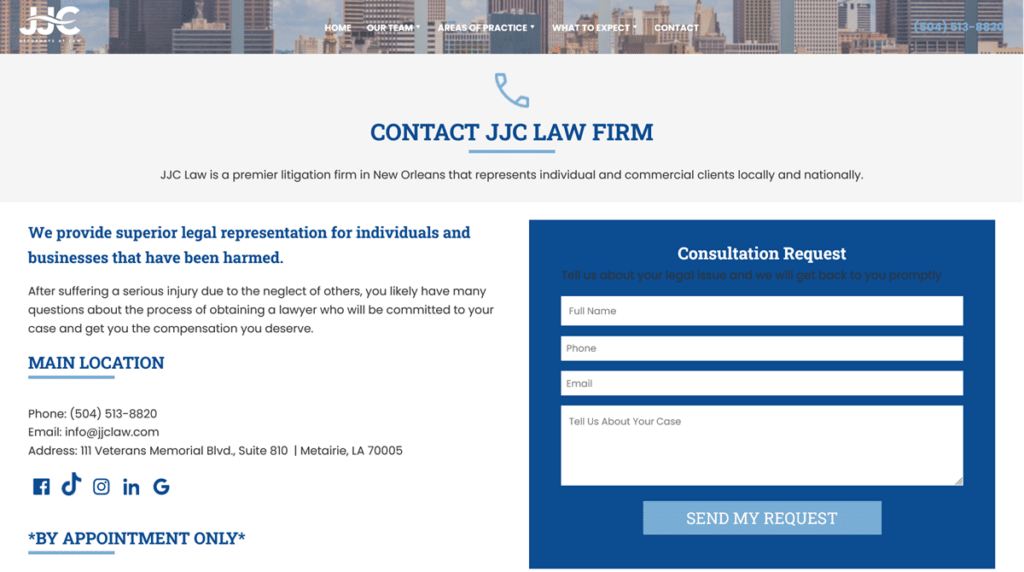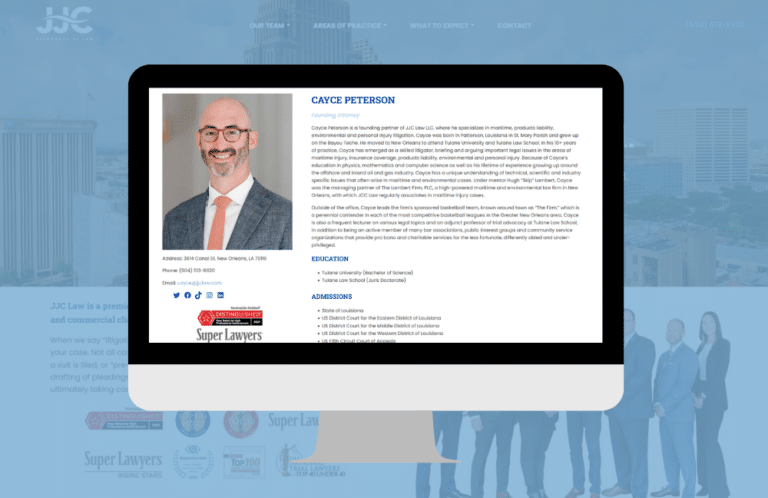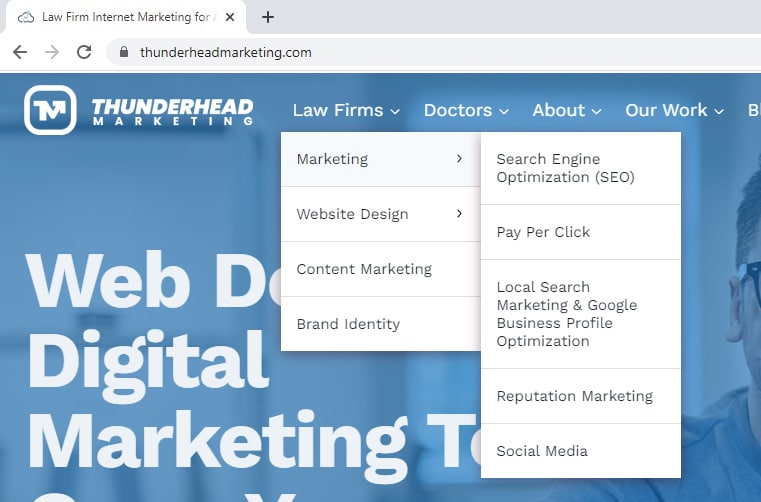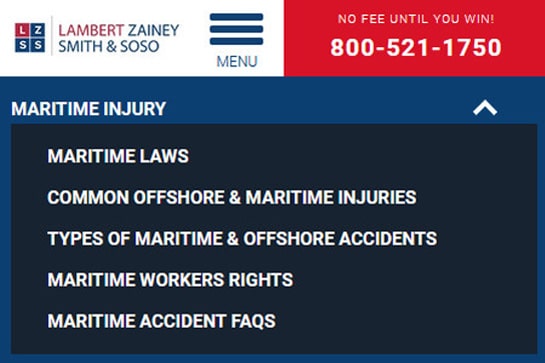A law firm’s website is more than just a digital brochure — it’s a powerful tool for establishing credibility, showcasing expertise, and converting visitors into clients. To maximize its impact, your website needs to be structured thoughtfully with essential pages that address your audience’s needs while incorporating key elements that boost your search engine rankings and user experience.
In this post, we’ll explore two critical aspects of creating a law firm website:
- The essential pages every law firm website should include.
- The key elements every page should incorporate, like CTAs, trust signals, and SEO strategies.
Whether you’re building a new site or auditing an existing one, this guide will ensure your website is working hard to attract and retain clients.
Essential Pages Every Law Firm Website Needs
These are the core pages that form the backbone of an effective law firm website. Each page serves a unique purpose, helping visitors find the information they need and guiding them toward taking action.

1. Homepage
The homepage is the cornerstone of your website. It’s the first interaction many potential clients will have with your firm, so it must convey professionalism, credibility, and clear next steps.
Key Elements:
- Clear Navigation: Make it easy for visitors to find the most important sections of your site, like Practice Areas, Attorney Profiles, and the Contact Us page.
- Compelling Value Proposition: Use a strong headline and subheadline to immediately convey what sets your firm apart, such as your expertise or unique approach.
- Service Overview: Include a brief overview of your practice areas with links to detailed pages.
- Visual Appeal: Use high-quality, professional images of your team or office to build trust and avoid clutter.
2. About Us
This page goes beyond your firm’s history — it’s a way to build trust and a personal connection with potential clients by showcasing your values, expertise, and mission.
Key Elements:
- Founding Story: Share the motivation and vision behind your firm’s creation.
- Team Bios: Include photos and bios of your attorneys and staff to humanize your firm and give visitors insight into who they’ll be working with.
- Mission and Values: Clearly state your firm’s mission and the core values guiding your practice, such as integrity, client-first focus, or community involvement.
- Professional Achievements: Highlight awards, certifications, and industry affiliations.
3. Practice Areas
This page should provide a detailed overview of the services your firm offers and is essential for potential clients who want to understand whether your firm can handle their specific legal needs. It should be well-organized and optimized for search engines.
Key Elements:
- Organized Layout: Clearly list your practice areas (e.g., personal injury, family law) with subcategories for more specific services.
- Detailed Descriptions: Provide brief but informative descriptions of each practice area, including the types of cases you handle.
- Client-Focused Language: Speak directly to potential clients by addressing their concerns and explaining how you can solve their legal problems.
4. Attorney Profiles

Attorney bio pages are among the most visited pages on law firm websites. Clients want to know who will be handling their case. Well-crafted profiles should showcase the expertise, qualifications, and personal approach of each attorney.
Key Elements:
- Professional Headshots: Use consistent, high-quality photos that present your attorneys as approachable yet professional.
- Comprehensive Bios: Include details about each attorney’s education, experience, and areas of specialization.
- Professional Achievements: Highlight notable cases, awards, and memberships in professional organizations.
- Personal Touch: Include personal interests or community involvement to humanize your attorneys and help clients feel more connected.
5. Client Testimonials
Client testimonials are a powerful tool for building trust and credibility on your law firm’s website. They provide social proof of your firm’s expertise and success, demonstrating to potential clients that you have a proven track record of delivering excellent results. A well-constructed Client Testimonials page can significantly influence a potential client’s decision to choose your firm over competitors.
Key Elements:
- Diverse Testimonials: Include testimonials from a variety of practice areas to show your range of expertise.
- Specific Outcomes: Encourage clients to share details about their cases and the positive outcomes they experienced.
- Visual Elements: Use client photos or video testimonials (with permission) to make the testimonials more engaging.
- Client-Focused Stories: Highlight personal stories that potential clients can relate to, making the testimonials more memorable.
6. Case Results
A case results page showcases your firm’s track record of success. This page provides potential clients with concrete examples of your expertise and the positive outcomes you’ve achieved, helping to build trust and credibility. By highlighting specific cases, you demonstrate your ability to deliver results, which can significantly influence a potential client’s decision to hire your firm.
Key Elements:
- Organized Layout: Organize case results by practice area or case type so visitors can easily find relevant examples.
- Detailed Case Summaries: Include a brief overview of each case, outlining the legal challenge and the successful outcome.
- Attorney Involvement: Mention which attorney handled the case to showcase their expertise.
- Success Metrics: If possible, include statistics such as settlement amounts or win rates to provide measurable proof of success.
7. Blog
A regularly updated blog is an invaluable component of a law firm’s website. It serves multiple purposes, from demonstrating expertise and engaging with clients to boosting SEO and driving traffic to your site. By regularly publishing high-quality, relevant legal content, your firm can position itself as a thought leader in the field and build stronger relationships with current and potential clients.
Key Elements:
- Informative Content: Address common legal questions, offer advice, and keep your audience informed about changes in the law.
- SEO Optimization: Use relevant keywords, internal links to service pages, and metadata to improve rankings.
- Case Studies and News: Include case studies, client success stories, or analysis of new legislation to demonstrate expertise.

8. Contact Us
The Contact Us page is one of the most important pages on your law firm’s website. It serves as a direct line of communication between potential clients and your firm, making it crucial to design this page with clarity and ease of use in mind. An effective Contact Us page can significantly increase the likelihood of potential clients reaching out for consultations or further information.
Key Elements:
- Contact Form: Use a simple form that collects only necessary information (name, email, phone, and message).
- Clickable Contact Information: Ensure phone numbers and emails are clickable, especially for mobile users.
- Interactive Map: Embed a Google Map for your office locations to make it easier for clients to find you.
9. Privacy Policy
The Privacy Policy page is essential for building trust with your website visitors by transparently explaining how you collect, use, and protect their personal information. It ensures compliance with legal standards and helps demonstrate your firm’s commitment to confidentiality and data security.
Key Elements:
- Data Collection Details: Explain what personal data is collected and how it’s used.
- Security Measures: Describe the steps your firm takes to protect personal information.
- User Rights: Include instructions for visitors to access, correct, or delete their personal data.
10. Terms of Service
The Terms of Service page is crucial for outlining the rules and guidelines for using your website. It sets clear expectations for users, protects your firm legally, and ensures that your website operates smoothly and professionally.
Key Elements:
- User Responsibilities: Specify what visitors are allowed and not allowed to do on your site.
- Liability Disclaimers: Limit your firm’s liability for any damages arising from the use of the website.
- Intellectual Property Rights: Clarify ownership of the content on your website and restrict unauthorized use.
Key Elements for High-Impact Law Firm Pages
Once you have the right pages, it’s crucial to ensure each page includes the right elements. These components help make the pages functional, engaging, and optimized for both users and search engines.
1. Call-to-Action (CTA) Best Practices
CTAs are essential for guiding visitors toward taking action. Every page should have at least one strong CTA.
Key Tips:
- Use action-oriented language like “Schedule a Free Consultation” or “Contact Us Today.”
- Position the CTA prominently on each page, ensuring it stands out but doesn’t overwhelm the content.
2. Trust Signals
Trust signals like testimonials, professional affiliations, and awards help establish credibility across your site.
Key Tips:
- Place client testimonials on high-traffic pages like the Homepage, Practice Areas, and Case Results pages.
- Display logos of professional associations or awards in a prominent location on your site.

3. SEO Optimization
SEO ensures that potential clients can find your site when searching for legal services online.
Key Tips:
- Use relevant legal keywords (e.g., “personal injury lawyer,” “criminal defense attorney”) in headings and throughout page content.
- Optimize each page with meta descriptions, title tags, and internal links to improve search engine rankings.
4. Visual Appeal
High-quality visuals make your website more engaging and professional.
Key Tips:
- Use consistent, professional headshots of attorneys, images of your office, and relevant icons or graphics.
- Incorporate videos where appropriate, such as attorney introductions or client testimonials.
5. User-Friendly Navigation
Good navigation ensures visitors can easily find the information they’re looking for.
Key Tips:
- Create a clear, logical menu structure that highlights the most important pages.
- Use breadcrumbs and internal links to improve user experience and keep visitors engaged longer.

6. Contact Information
Make your contact information easily accessible across the entire site.
Key Tips:
- Include clickable phone numbers and email addresses, especially for mobile users.
- Ensure office addresses link to Google Maps for easy navigation.
7. Content Layout and Readability
Content that is well-organized and easy to read keeps visitors on your site longer and increases conversion rates.
Key Tips:
- Use short paragraphs, bullet points, and subheadings to break up large blocks of text.
- Ensure your content is mobile-friendly and easy to navigate on smaller screens.
Need Help Bringing It All Together?
By ensuring your law firm’s website includes these essential pages and key elements, you can create a site that not only attracts potential clients but also converts them into actual clients. You don’t have to do it alone, though. At Thunderhead Marketing, we specialize in crafting professional and effective websites for law firms. Our team of experts understands the unique needs of legal professionals and is dedicated to helping you create a website that stands out.If you’re ready to take your law firm’s online presence to the next level, contact Thunderhead Marketing today for a free website audit and consultation. Let us help you build a website that’s optimized for success.







